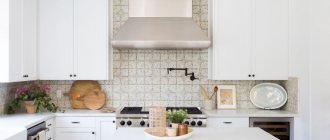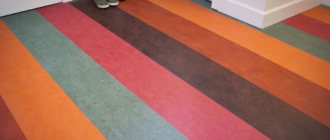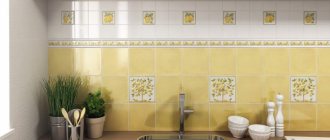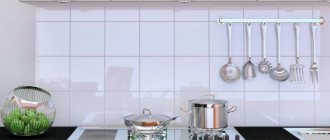Modern finishing materials are distinguished by a variety of colors, shapes and properties. Thanks to this, everyone can realize their dreams of an ideal interior in their home. However, when developing a design project or even simple estimates, you should understand what exactly the market can offer in principle. For example, a clear understanding of what the standard sizes of wall tiles are will help you accurately calculate the required quantity, and therefore save money.
Classic ceramic tile format
Throughout the 20th century, in many apartments and houses one could see the decoration of utility rooms, including the kitchen and bathroom, with white ceramic tiles and standard sizes of 10X10 and 15X15 cm.
- The usual size of tiles is considered classic and the most universal, as it is suitable for structures of various purposes and sizes.
- On a surface covered with ordinary tiles of average parameters, an acceptable number of seams is created, with the least waste.
- It is especially in demand for finishing architectural structures of complex geometric shapes.
When laying medium ceramic tiles, wedges are used instead of plastic crosses, which helps to more accurately form the distances between the piece finishing material.
Standard sizes
With a variety of floor covering parameters, there are standard parameters. This option is considered to be a square tile with a side of 300 mm. The following parameters in millimeters are considered standard:
- Square: 48x48, 100x100, 150x150, 200x200, 250x250;
- Rectangular: 100x1200, 150x300, 200x300;
- Pentagonal: 86.5x150, 98x170, 115x200;
- Hexagon: 150x173, 200x230;
- Triangular: 58x83, 83x118, 98x139.
Most often, buyers purchase standard tiles for installation, since this shape and parameter is suitable for most interior options.
Multifaceted tile formats
Large format ceramic tiles
Until recently, large ceramic tiles were used to cover large areas of industrial buildings or retail spaces. But recently, large-format tiles have been actively used in the interior design of residential buildings and spacious apartments.
Sometimes it can be seen among the external decoration elements of various buildings. Large tiles include ceramic products with one side measuring from 50 to 120 cm. Most often on sale you can find large tiles with perimeters of 60X90, 90X90, 60X120 cm.
A relatively new variety are elongated tiles, the patterns of which often imitate natural stone or natural wood. They are laid in different ways, including in a herringbone pattern, like parquet.
Among the main advantages of large-format tiles are the following:
- The smallest number of seams between tile units, which helps to perceive the surface as solid.
- The minimum number of tiles in each square meter significantly speeds up the installation process.
- The fewer seams are created when finishing with tiles, the easier it is to maintain and maintain hygiene in the room, since dirt and mold are less likely to form in them.
The largest sized tiles are composite materials, such as porcelain stoneware, and are used for laying floors in rooms with high humidity or for exterior finishing of facades.
Facade cladding
If you are faced with the task of cladding the facade of a building, it will be useful to learn about existing standards. As in all of the above cases, square and rectangular tiles can be laid on the façade.
The following standards are known today:
- Rectangular tiles – 71×46, 120×65, 192×142, 213×111, 213×107, 250×65, 250×140, 292×92, 292×142 and 292×192 mm.
- Square tiles – 21×21, 46×46, 48×48, 71×71, 92×92, 142×142, 192×192 and 292×292 mm.
Conclusion So, as you can see, the choice of tiles is not limited only to style and design, for example, whether it will be laminated or matte. The size and thickness play an important role. We hope that our material helped you understand all the types of tiles. Additionally, you can watch the prepared video material.
Small or mosaic tiles
Small finishing tiles are considered to be ceramic products whose dimensions are 6X6, 5X5 cm or less. Very small mosaic elements are glued onto strips of fiberglass mesh, together with which they are laid on a cement-adhesive mortar.
Small-sized tiles also have their advantages:
- Beautiful mosaic patterns are selected on a matrix grid, and the cladding masters only have to lay the finished fragments.
- Preparing the surface for laying small tiles does not require special care.
- Smoothly and efficiently covers any bends or waves of a curved surface.
When using small-format mosaic tiles for finishing utility rooms, it should be taken into account that a large number of joints are more dirty and less hygroscopic. Caring for such finishes in the kitchen or bathroom becomes more labor-intensive.
Common mistakes
- The cabinets back up against the tiles.
Why did this happen: they didn’t take into account the thickness of the countertop when drawing up the project.
How to fix it: meticulous adjustment to size, but without loss for aesthetics, does not always work.
- The thickness of the apron interferes with the installation of the kitchen.
Why did this happen: the apron was laid out after the initial measurements and repeated measurements were not made to clarify the data.
How to fix: consistently “hammer” the headset, but this is only possible with a difference of no more than 2-3 mm.
- The apron is laid out first, and then the kitchen is installed.
What it can lead to: size mismatch, inability to fit sections, spoiled aesthetics.
How to fix it: unfortunately, remove the apron and begin installation in the correct sequence.
Suitable wall tile sizes
In the process of specialists acquiring vast practical experience in finishing buildings using tiles, several of the most optimal sizes for laying on walls were identified.
Craftsmen recommend using square tiles with dimensions of 20X20 cm for tiling work in bathrooms or kitchens, and rectangular tiles with sides of 20X30 or 20X45 cm.
Rectangular tiles laid horizontally increase the number of transverse seams and visually expand the space of small rooms. Accordingly, vertically distributed elements of the tiled covering visually increase the height of the walls.
- In bathrooms and bathrooms there is often a need to hide protruding fragments of communications or to tile structures of complex geometric shapes. For these purposes, medium or small format ceramic tiles are used.
- When laying rectangular tiles diagonally, you can smooth out imperfections in the layout of utility rooms, and uneven walls will become less noticeable. To get a brick pattern on the wall, you should choose a rectangular tile, one side of which is twice as large as the other.
For complex modular masonry, carried out by experienced craftsmen, special decorative types of tiles of different sizes are used, some of which can be produced in limited quantities as experimental ones.
Difficulties in decorating a bathroom
A sanitary room is a room in which daily hygiene procedures take place. The floor and wall in this room are constantly exposed to the same load, and tile materials can cope with it. Due to limited space, not all of their varieties can be used to decorate a bathroom. In order to understand what sizes of tiles are most optimal for the room being described, it is necessary to describe in detail the existing classification of tile coverings.
Features of floor tiles
Products with a thickness of 8 to 11 mm, coated with a hard and wear-resistant protective layer, are suitable for covering the floor with ceramic tiles.
- From medium-sized tiles for the floor, square tiles are purchased in the formats 20X20, 30X30, 330X330, 40X40 and 45X45 cm, as well as rectangular tiles - 10X20, 150X30, 20X30, 30X40 cm.
- In addition to the simple common geometric shapes of tiles for flooring, 5-, 6- and 8-carbon ceramic products are less common. In rooms intended for garages, warehouses or other increased operational loads, the floor is covered with porcelain stoneware.
- This composite material is resistant to mechanical and chemical influences, humidity and fire. Porcelain stoneware goes on sale in the form of rectangular or square tiles, the standard sizes of which are from 20X20 to 60X60 cm.
When choosing tile cladding, you should pay attention not only to its aesthetic qualities, but also to the wear resistance classification, which directly depends on the size of the tile.
Advantages and disadvantages
The popularity of ceramic tiles is due to the fact that they:
- environmentally friendly - it consists of natural ingredients that are absolutely safe for humans. The material is made from several types of clay and sand;
- durable - tile is several times superior to concrete in its ability to withstand heavy loads. It obtains such properties as a result of hot pressing and firing;
- resistant to moisture – has a dense waterproof coating, so it does not absorb water, grease, detergents, odors, and prevents the formation of fungus;
- resistant to scratches, abrasions and other minor damage due to the technology of calcination and formation of the surface layer;
- resistant to sunlight - the color of the background, patterns and ornaments does not change over time - does not fade;
- fire resistant - does not support combustion and does not melt;
- practical - ceramic coating is not afraid of exposure to cleaning agents;
- Suitable for any interior - tiles are available in a huge variety of colors and textures.
Weaknesses of the material:
- high thermal conductivity - the surface of the tile is always cold. Walking on it barefoot is unpleasant and dangerous to health. However, the “warm floor” system will easily solve this problem;
- fragility - tiles should be transported and handled very carefully, as they are easy to split. Heavy and sharp objects falling on tiles can cause irreparable damage;
- insufficient sound insulation - additional protection is required in the form of a layer of sound-proofing material, which leads to an increase in the cost of the process;
- slippery surface - moving on tiles with a glazed coating is very difficult, especially if it is wet. Therefore, for the bathroom you should prefer products with a rough surface.
When choosing a material for repair, consider all the positive and negative aspects of the material. This will help you choose the best option for you.











